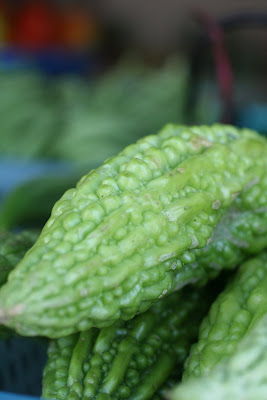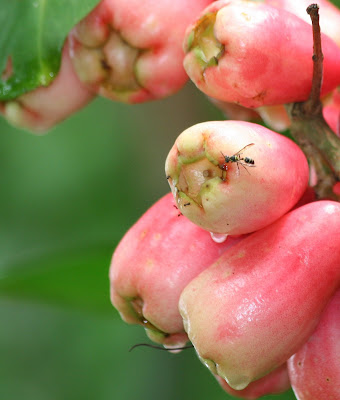I'm continuing my edible theme to remind myself how lucky we are to have so many delicious things growing around us in the Tropics. We don't grow apples and pears, or peaches, blueberries, strawberries or raspberries. But we do grow pineapples, bananas, guavas, sapodillas, mangoes, sugar apples, West Indian cherries, clove, cinnamon, nutmeg, cocoa, coffee, roucou, cashews and pommecythere, to name a few. 


The above odd looking fruit/vegetable is roucou or annatto. It was used as far back as the Amerindians as a preservative and is a very popular additive in our Christmas pastelles. It stains a deep red and has very little flavour. This is the fruit on the tree. Once removed from the tree, it dries and turns brown and the pod splits to reveal the little seeds that provide the colour. Cocoa off my tree. I do believe that I have very good quality cocoa. I bought the tree from the Government farm in Centeno and it gives me big, healthy, pretty cocoa.
Cocoa off my tree. I do believe that I have very good quality cocoa. I bought the tree from the Government farm in Centeno and it gives me big, healthy, pretty cocoa.
This is my favourite fruit, the sugar apple. It grows best under arid conditions and so is happiest "down the islands" where it grows almost wild. It is an unusual fruit that you split open and suck the pulpy white fruit off the black seed. It is quite a labour intensive fruit but well worth the effort. It is sweet with the slightest undertone of of an indescribable flavour.
Post Note on the Dec 1:
I didn't know a whole lot about the sugar apple so could not answer whether it was, in fact, a custard apple. I'm going to cut and paste what I got from Wikepedia which seems to answer the question.
In some regions of the world, the sugar-apple is also known as custard-apple, a different plant in the same genus.
Annona squamosa (Sugar-apple, Sweetsop or Custard Apple) is a species of Annona native to the tropical Americas. Its exact native range is unknown due to extensive cultivation, but thought to be in the Caribbean; the species was described from Jamaica.
It is a semi-evergreen shrub or small tree reaching 6-8 m tall. The leaves are alternate, simple, oblong-lanceolate, 5-17 cm long and 2-5 cm broad. The flowers are produced in clusters of 3-4, each flower 1.5-3 cm across, with six petals, yellow-green spotted purple at the base.
The fruit is usually round or oval, slightly pine cone-like, 6-10 cm diameter and weighing 100-230 g, with a scaly or lumpy skin. The fruit flesh is edible, white to light yellow, and resembles and tastes like custard. The seeds are scattered through the fruit flesh; they are blackish-brown, 12-18 mm long, and hard and shiny.



















































